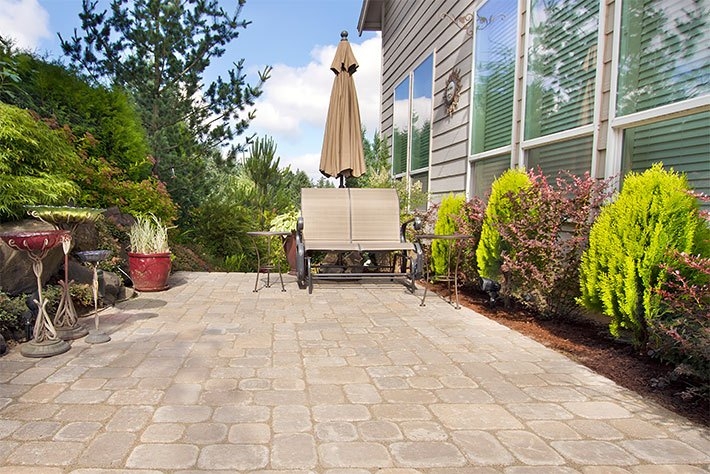
Adding a patio to your home is a smart decision and can be a great investment. It extends the livable area of your home and creates an inviting space for entertaining friends and family. By working with a knowledgeable deck and patio builder, your patio can be as simple or as grand as your imagination (and budget) can handle. Deciding on the design of the patio, however, should not be your first decision. Rather, spend some time deciding on what material you want to use in creating your patio, which will help to drive other decisions you make during this project.
Generally, your patio material choices are paver stones and concrete slabs, both of which have benefits and drawbacks. Some homeowners allow this decision to be driven strictly on price alone. Although there can be a significant difference in upfront costs, there are other topics that should be taken into consideration for your particular home.
The Difference
Pavers are individual concrete ‘blocks’ that come in a variety of sizes, shapes and finishes. They typically are long lasting and can be replaced individually, if necessary, making upkeep fairly simple. Seam lines where the stones meet are filled with sand to maintain a tight lock. Concrete slab is a poured rock (think most sidewalks) that takes the shape of the form chosen, and can be left as a blank slab (again, like a sidewalk, possibly with contraction joints to minimize cracking), or can be stamped while still went to give it a custom look.
Understanding the differences in the materials can help to make your decision. From a drainage standpoint, pavers provide a porous surface, through which rain and snow can penetrate. This allows for proper drainage through the area and improved skid-resistance. Concrete slab, due to its continuous surface, tends to retain water on the surface, which requires suitable angling away from the home to provide proper drainage, increases the potential for slippery surfaces and, depending on the finish, has a tendency to give off glare in the sunlight. Concrete also settles slower than pavers, which can act as a tripping hazard if one or more pavers settle more than those around it.
How It Looks
Aesthetics is a key consideration in your patio choice as well. You want something that complements your home and yard, and provides a sufficient space for whatever activities you plan on for that area. Paver patios can provide a long lasting, classic look to any area, and provide plenty of flexibility in the design of your patio because they can be arranged in a myriad of ways. On the other hand, concrete slab, particularly stamped concrete, can be customized into intricate designs or can mimic the look of a variety of natural stones, in both shape and color!
Upkeep is sometimes the last topic that homeowners consider when deciding on the patio choices, but plays an important part in the beauty, longevity and cost of your investment. In terms of cost, standard, non-stamped concrete slab is the lowest upfront cost. However, even with appropriate occasional sealing, it is nearly guaranteed to form cracks eventually. Upkeep on this will require patching cracks, which may or may not match the original look of the patio, and large repairs require jackhammering and removing the existing concrete. Therefore, it has the potential for more expenses for long term upkeep. Stamped concrete tends to be more expensive, but the stamping benefits the slab by providing natural areas for cracks to occur in spaces that are less noticeable. It will still require the same kind of upkeep, but you may not have to repair cracks as soon. Finally, paver patios represent the largest upfront investment. However, if pavers are damaged or become uneven, they can be replaced individually, which keeps long term upkeep costs down while allowing you to match the original look of the stones.
Take a little time and consider these points before making your final choices to ensure you know exactly what to expect with your new patio and can make the best decision for your family’s needs.

Recent Comments